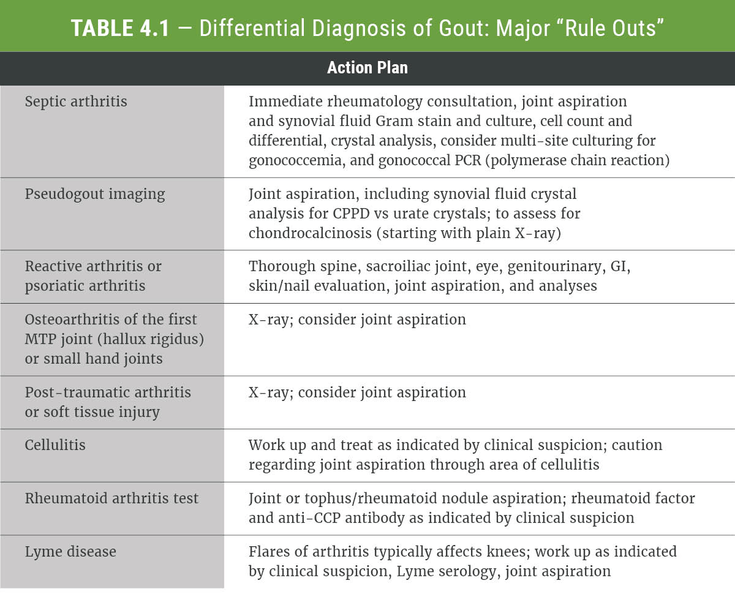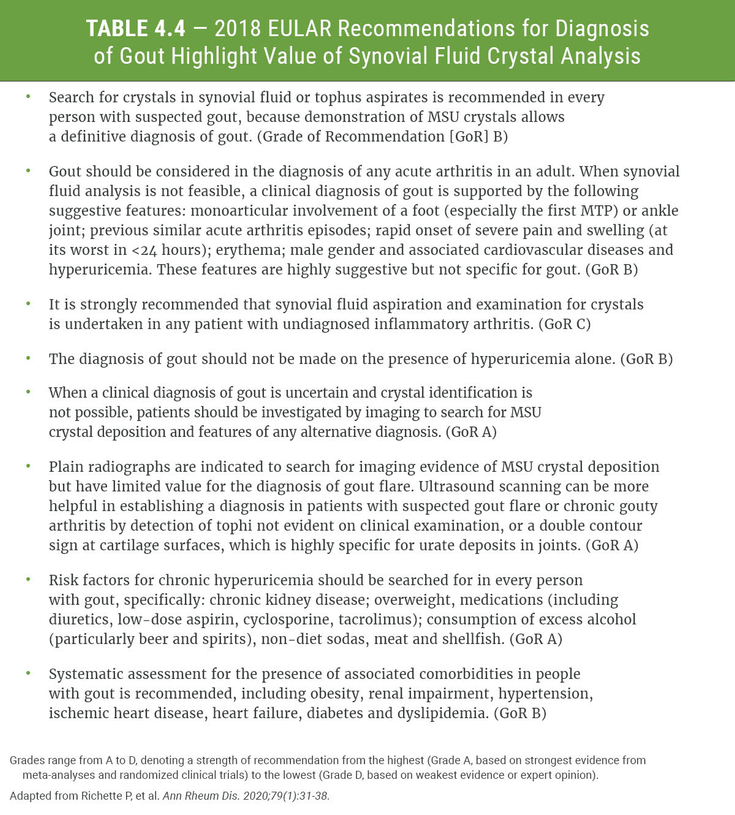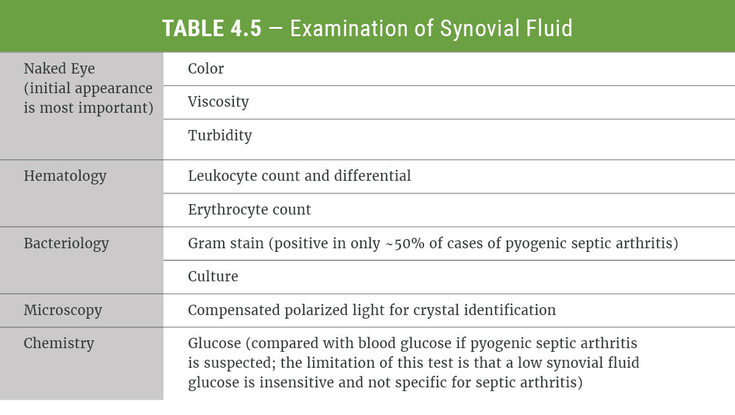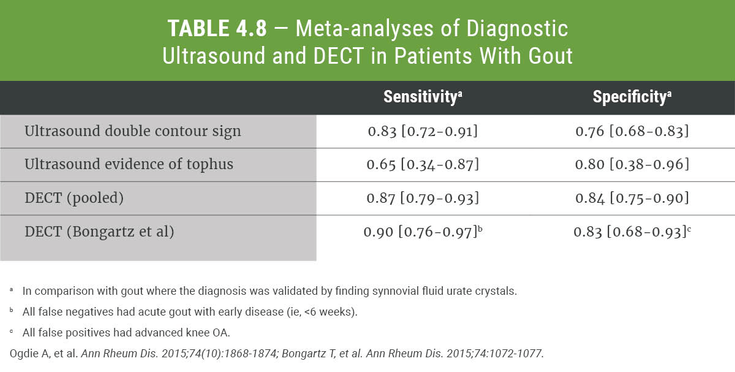Diagnosis of Gout and Use of Laboratory and Imaging
Introduction
The diagnosis of gout sets into motion an assessment and therapeutic program for comorbidities, plus an enduring treatment program for gout-flare treatment and prophylaxis and serum urate lowering. Therefore, an early and correct diagnosis of gout is essential and cost-saving. For example, a correct diagnosis of gout, rather than a mistaken diagnosis of septic arthritis, can avoid unnecessary inpatient admission and appropriately direct treatment of the excruciating acute pain typically associated with gout. Gout diagnosis involves thoughtful consideration of the differential diagnosis and the use of clinical, lab and imaging criteria to support and establish the diagnosis of gout, as well as attention to the underlying etiology of the hyperuricemia.
Identification of the cause of hyperuricemia helps to select appropriate nonpharmacologic and pharmacologic measures to correct the hyperuricemia, and can also reveal previously unsuspected medical conditions that cause uric…
To continue reading
Log in or register to continue reading. It's free!
OR
By signing up to create an account, I accept Healio's Terms of Use and Privacy Policy.
Introduction
The diagnosis of gout sets into motion an assessment and therapeutic program for comorbidities, plus an enduring treatment program for gout-flare treatment and prophylaxis and serum urate lowering. Therefore, an early and correct diagnosis of gout is essential and cost-saving. For example, a correct diagnosis of gout, rather than a mistaken diagnosis of septic arthritis, can avoid unnecessary inpatient admission and appropriately direct treatment of the excruciating acute pain typically associated with gout. Gout diagnosis involves thoughtful consideration of the differential diagnosis and the use of clinical, lab and imaging criteria to support and establish the diagnosis of gout, as well as attention to the underlying etiology of the hyperuricemia.
Identification of the cause of hyperuricemia helps to select appropriate nonpharmacologic and pharmacologic measures to correct the hyperuricemia, and can also reveal previously unsuspected medical conditions that cause uric acid overproduction or renal uric acid underexcretion (discussed in detail inDisease Definition and Overview and Who Gets Gout?). As such, clinicians always need to consider what the potential cause(s) of hyperuricemia and triggers of gout are in the individual patient. This typically involves assessment of:
- Family history
- Blood pressure history
- Diet
- Alcohol intake
- Medications (such as diuretics)
- Thorough physical examination including skin
- Hemogram
- Urinalysis
- Renal and hepatic function tests, and metabolic panel.
In patients with hyperuricemia and good renal function where the cause of hyperuricemia is not obvious, assessment of 24-hour urine uric acid excretion is valuable, as it can point to an unsuspected condition causing uric acid overproduction, or can help identify heritable renal uric acid overload due to dysfunctional urate transporters (see Disease Definition and Overview). In either circumstance, an elevated uric acid level (>800 mg/day) in an adequate 24-hour urine collection indicates a major contraindication to uricosuric monotherapy.
When There Is Reasonable Doubt About the Diagnosis of Acute or Chronic Gouty Arthritis, the Gold Standard Is to Aspirate the Joint for Diagnosis
The definitive diagnosis of acute gout is made by detecting urate crystals in a symptomatic joint in the absence of infection. In this regard, the inflammatory process of septic arthritis can loosen urate (and calcium pyrophosphate dihydrate [CPPD]) crystals from joint structures; on some occasions, urate and CPPD crystals are detected in infected joints. Conversely, septic arthritis is more frequent in joints with underlying pathology, such as RA, a prosthetic joint, tophaceous gout, or CPPD deposition disease. However, only a small fraction of joints with suspected gout (estimated at ~10%) undergo aspiration in clinical practice, with primary care practices the most logistically challenged to perform joint aspiration and crystal analysis of synovial fluid.
As discussed below, high-resolution ultrasound imaging can detect urate crystal deposition and tophi but with substantially less than complete sensitivity or specificity (unlike the very high specificity of detection of urate crystals by compensated polarized light microscopy, when done by skilled observers). The use of ultrasonography in rheumatology has expanded greatly in recent decades. As late as 2010, an ACR survey revealed that less than two thirds of ACR members and rheumatology fellows employ ultrasound in their practice, with only about 20% performing the imaging themselves. Towards the end of the decade, musculoskeletal ultrasound training became routine in rheumatology fellowship programs, with 94% of the programs offering ultrasound training and 41% having a dedicated ultrasound curriculum. These developments reflect the increasingly important role of ultrasound in rheumatology practice.
Dual-energy computed tomography (DECT) is a more expensive approach than ultrasound, has size limits in the resolution of tophi that may lead to false negative findings in early disease, and some false positives can also occur. Where available, ultrasound and DECT imaging approaches to detect tissue urate crystal deposits are very useful. This is especially so in cases where joint aspiration cannot be performed due to location of the arthritis or lack of consent by the patient, or to help diagnose gouty arthritis at a time point where the joint is asymptomatic, and there are no acute clinical symptoms to prompt immediate joint aspiration.
Importantly, the 2015 ACR/EULAR Classification of Gout (Synopsis and Assessment of the 2015 Gout Classification Criteria) gives an equal scoring weight (of 4 points) to the finding of one or more palpable tophi, positive ultrasound finding of a “double contour sign” indicative of urate crystal deposition on the articular cartilage surface, or positive DECT for urate crystal macro-aggregates. However, ultrasound and DECT appear to have less sensitivity in the setting of acute gout and have been less well studied in patients with early, less-established disease. In the diagnosis of acute and chronic inflammatory arthritis, these imaging approaches do not supplant the rapidly obtained and very broad diagnostic information from joint aspiration, with synovial fluid Gram stain and culture, synovial fluid cell counts and differential and crystal analysis by compensated polarized light microscopy (PLM) and polychromatic polarization microscopy; Raman spectroscopy has more recently been shown to significantly enhance the specificity and objectivity of diagnosis when integrated with PLM. In skilled hands, diagnostic joint aspiration is associated with few adverse events, and it can be safely performed even in therapeutically anti-coagulated patients.
Therefore, when there is reasonable doubt about the diagnosis of acute or chronic gouty arthritis, the best practice is to aspirate the joint (unless it is not technically feasible or is contraindicated due to suspected overlying bacterial cellulitis or a severe bleeding tendency). The synovial fluid should be analyzed for crystals and infection, which may require an urgent rheumatology or interventional radiology consultation or emergency department (ED) visit.
Differential Diagnosis of Gout
Major entities in the differential diagnosis of gout and corresponding action plans are summarized in Table 4-1.
Infectious (Septic) Arthritis
Septic arthritis is a true medical emergency since the process can destroy joint structures and is life-threatening. Immediate rheumatology consultation, joint aspiration, synovial fluid Gram stain and culture, cell count and differential and crystal analysis are advised. Blood cultures are indicated if sepsis is suspected, and if disseminated gonococcal infection is suspected, obtaining blood cultures and cultures at multiple other sites, including some where gonococcal infection can be carried with little or no symptomatology (pharyngeal, rectal, urethral, vaginal [cervical], skin lesions) is advised. Gonococcal detection by polymerase chain reaction (PCR) has provided a major advance. Septic arthritis, suspected or established, is an indication for immediate inpatient admission.
Pseudogout
Acute flares of pseudogout (due to CPPD crystal deposition disease) can be clinically indistinguishable from acute gout but favor larger joints (e.g., knee, wrist) rather than the first metatarsophalangeal (MTP) joint or tarsal joints in which acute gout so commonly presents. Joint aspiration, including synovial fluid crystal analysis for CPPD vs urate crystals, and plain X-ray (or more sensitive ultrasound), or DECT, to assess for chondrocalcinosis are indicated when pseudogout is suspected. Unlike gout, pseudogout is rare under age 50 and uncommon prior to age 60.
Osteoarthritis
Osteoarthritis (OA) of the first MTP joint (hallux rigidus) (Figure 4.1A) or small hand joints (Figure 4.1B) can present with painful, inflammatory flares accompanied by swelling and sometimes with erythema (Figure 4.1C). However, OA and gout frequently coexist and OA is a risk factor for development of gout in the affected osteoarthritic joints, such as Heberden’s and Bouchard’s nodal OA of the hands. Imaging or joint aspiration will be needed to diagnose gout.

Posttraumatic Arthritis or Soft Tissue Injury
Joint pain, joint effusion (typically noninflammatory or hemorrhagic) and/or soft tissue pain and swelling involving ligaments and tendons can develop after trauma. Conversely, acute gout (and pseudogout) are commonly precipitated by trauma. Imaging and joint aspiration may be necessary to help resolve the differential diagnosis between gout and posttraumatic arthritis or soft tissue injury.
Spondyloarthropathy
Reactive arthritis or psoriatic arthritis can present with acute painful flares in one or a few joints. Thorough spine, sacroiliac joint, eye, genitourinary, gastrointestinal (GI) and skin/nail evaluations are indicated. Radiographic evaluation and joint aspiration may be needed to complement clinical evaluation in such clinical scenarios.
Bacterial Cellulitis
Gout can involve periarticular structures and present with sterile cellulitis over the inflamed joint(s); assessment for joint tenderness on passive motion may be helpful when gout is suspected. Conversely, bacterial cellulitis, particularly of the forefoot, midfoot and ankle, can be quite painful and tender, and can clinically suggest gout. Work up and treat the patient as indicated by clinical suspicion, and exercise caution to avoid joint aspiration through an area of cellulitis.
RA
Gout can present as chronic, bilateral proliferative polyarthritis, particularly in the hands, and olecranon bursae, and other soft tissue nodules in RA and tophaceous gout can resemble each other. Joint aspiration or tophus vs rheumatoid nodule aspiration is often helpful in this setting. Aspirating white, grossly chalky crystals from a tophus is, by itself, sufficient for gout diagnosis without crystal analysis. Imaging, rheumatoid factor and anti-cyclic citrullinated peptide (CCP) antibody testing for RA may be indicated by clinical suspicion.
Lyme Disease
Acute flares of arthritis are common in Lyme disease and typically affect one of the knees. Work-up is indicated by clinical suspicion and geographic region or travel history, and Lyme serology and joint aspiration should be part of the work-up.
How to Integrate Clinical, Lab and Imaging Information to Support and Establish the Diagnosis of Gout
The Gold Standard for Diagnosis of Acute Gout is Most Frequently Not Performed
For the definitive diagnosis of gout, the gold standard of detection of MSU crystals by aspiration of joint fluid or a tophus is most frequently not done. Table 4-2 summarizes the ideal vs pragmatic, real-world practice issues regarding diagnostic arthrocentesis for gout. Correspondingly, diagnosis based on typical clinical features of gout and documented hyperuricemia is flawed (Synopsis and Assessment of the 2015 Gout Classification Criteria). The misdiagnosis of gout is substantial when based only on the triad of inflammatory arthritis, hyperuricemia and clinical response to colchicine.
Limitations of Existing Formal Criteria for Diagnosis of Acute Gout
Many formal criteria for diagnosis of acute gout have been developed and evaluated over the last 4 decades, but none have been ideal (Synopsis and Assessment of the 2015 Gout Classification Criteria). For example, use of the commonly used 1977 American College of Rheumatology (ACR) Preliminary Criteria for Acute Gout Flare leads to an erroneous diagnosis in ~20% of cases and has limited applicability to primary care practice and in-office diagnosis. The 1977 clinical ACR criteria components for acute gout do provide useful information to heighten clinical suspicion of gout (Table 4-3). They include pointing out the frequency of unilaterality of arthritis (for gout flares), the rapid onset and ascent of inflammation within the first 24 hours (in step with typically excruciating pain), midfoot or first MTP joint involvement, as well as a history of prior episodic arthritis. It should also be noted that redness over affected joints or bursae is often followed by skin desquamation as the acute flare resolves in acute gout.
Complexities in differential diagnosis of gout, polyarticular involvement, systemic symptoms such as fever and elevated systemic leukocyte count can all occur in acute gout, but have not been factored into formal gout diagnosis criteria. Furthermore, the plain radiography and lab criteria within the original 1977 ACR gout criteria are flawed because plain radiographic changes typically take years to develop in gout, and hyperuricemia may be lessened or absent during the acute phase of a gouty arthritis flare. The European League Against Rheumatism (EULAR) approach to the diagnosis of acute gout emphasizes the high specificity of synovial fluid crystal analysis, and the substantially lower specificity of not only plain radiographic features but also acute pain in the great toe (podagra) (Table 4-4).
2016 Agency for Healthcare Research and Quality (AHRQ) Assessment of Gout Diagnosis Criteria
In 2016, AHRQ published their extensive systematic review of the entire literature on the accuracy of gout diagnostic tests, compared with a validated reference standard in those without a prior diagnosis of gout. They focused on six clinical algorithms composed of clinical signs and symptoms, and tested for diagnostic accuracy by assessing for synovial fluid urate crystals in affected joints. Their work highlighted prior results for two primarily clinical algorithms that do not require proof of urate crystal deposition in tissues, (i) the “Diagnostic Rule,” developed and validated in primary care, and (ii) the “Clinical Gout Diagnosis (CGD)” algorithm, which had sensitivity of 88 and 97%, respectively and specificity of 75 and 96% respectively, when applied to patients with shorter and longer durations of symptoms (defined using 2 years as the dividing line). However, the strength of evidence supporting use of these clinical criteria was low, with validation still needed in multiple practice environments, and the authors of this handbook do not advocate use of these criteria for diagnosis in US clinical practice.
How the Authors of this Handbook Assess Best Use of Existing Clinical Gout Diagnostic Criteria
We view the lab data (crystal analysis, documentation of hyperuricemia) and imaging data as essential for accurate diagnosis of gout. Clinical gout diagnostic criteria are best used to guide referral, by primary care, of diagnostically challenging cases to rheumatologists and radiologists for appropriate lab testing and imaging that should include rigorous identification of tissue deposits of urate crystals.
Use of the Laboratory to Analyze Synovial Fluid in Diagnosis of Gout
In acute gout, at the time of sampling during the acute flare, the serum urate may be normal (≤6.8 mg/dL) in ~15% of patients, or, in up to 40% to 50% of patients, only slightly elevated (<8 mg/dL) (Figure 4-2). Conversely, asymptomatic hyperuricemia is common, including in patients with arthritis due to conditions other than gout. Hence, aspiration and analysis of joint fluid to confirm the presence of MSU crystal remains the gold standard and familiarity with this technique is an asset for the diagnosis of gout.

Examination of Joint Fluid
Table 4-5 lists the synovial fluid examinations that can be carried out (if fluid volume is sufficient and each test is clinically indicated). The initial, gross appearance of the joint fluid (clear, cloudy, or bloody) and viscosity (normally viscous but watery in inflammatory arthritis) are important to assess and record. Joint fluid is always inflammatory in acute gout (Figure 4-3). Inflammatory joint fluid is typically defined as having a leukocyte count over 1000 or 2000 per mm3, in which event a gross quality of the fluid is that it does not allow one to read print through the fluid (Figure 4-3).
There is an elevated proportion of neutrophils in acute gouty joint fluid. However, in gout there is generally <90% neutrophils, whereas in pyogenic septic arthritis, there is typically close to or >90% neutrophils in the synovial fluid. The total leukocyte count is most often in the inflammatory range of 1,000 to 50,000/mm3 in acute gout but sometimes is in the turbid, purulent range of >50,000/mm3 more typically seen with joint infection. Conversely, many cases of infectious arthritis have joint fluid leukocyte counts in the inflammatory, nonpurulent range.
Importantly, the clinical significance of finding a joint fluid with a leukocyte count >50,000/ mm3 is that, unless there is certainty that the diagnosis is not infectious arthritis, a joint fluid with a leukocyte count in this range is generally an indication for inpatient admission and coverage with antibiotics until joint fluid Gram stain and culture all return as negative. This is always the way to manage a presentation with grossly purulent synovial fluid.

Synovial Fluid Crystal Analysis by Compensated Polarized Light Microscopy
In this technique, a small suspension of joint fluid is studied; even less than a drop is sufficient, such as the amount of material collected in the needle and sprayed on the slide. The joint fluid sample, if sent to the lab, should be in a tube that does not have added anticoagulants. The joint fluid is examined for approximately 5 minutes to firmly rule out the presence of crystals. The fluid is best examined as a fresh specimen but can be left (ideally at 4oC) for later examination. If crystals are not found on the wet preparation, the remaining joint fluid can be centrifuged to analyze the pellet and increase yield. A suspected tophus can provide an excellent specimen. Even Gram-stained slides can be examined for urate and CPPD crystals within leukocytes. Tissue sections (fresh or fixed in ethanol) also can be examined for urate crystals by compensated polarized light microscopy, but formaldehyde-fixed samples cannot be employed since formaldehyde dissolves urate crystals. EDTA, used in some tubes as an anticoagulant, dissolves CPPD crystals.
The setup of the compensated polarized light microscope is illustrated in Figures 4-4A and 4-4B. These instruments are available in most rheumatology offices, many clinical chemistry labs and pathology departments. Inexpensive crossed polarized filters and a first-order red-plate compensator can be used to fashion a crude but effective compensated polarized light microscope from a standard biologic microscope. Birefringent particles, not limited to urate and CPPD crystals, bend light into slow and fast components and shine brightly in a dark field created by use of crossed polarizing filters. The first-order red-plate compensator also has an axis of slow rotation of light, and this is employed to determine negative and positive birefringence (for urate and CPPD crystals, respectively).
In acute gouty synovial fluid, urate crystals are seen both inside and outside neutrophils, with a detection rate >95%, although there is variability between examiners. Urate crystals also can be seen in joint fluid of asymptomatic gout patients and in some with asymptomatic hyperuricemia. In that clinical situation, the crystals may be primarily extracellular. Urate crystals are needle-shaped (Figure 4-5) and range from 2 to 20 microns in length; by reference, a neutrophil has a diameter of ~15 microns (Figure 4-6) and has a bright, negative birefringence (Figure 4-7). The urate (or CPPD) crystal appears yellow or blue, depending on whether it is parallel or perpendicular to the axis of the slow rotation of light of the compensator. Birefringence becomes extinguished between these angles (Figure 4.7), making a microscope with a rotating stage useful.
CPPD crystals, unlike urate crystals, are only weakly birefringent and are positively birefringent (Figure 4-8). The CPPD crystals are more variable in shape than urate crystals and more challenging for inexperienced observers to accurately detect. In the same joint fluid, one can see intracellular and extracellular rod-shaped CPPD crystals that resemble urate crystal needles, and rhomboid-shaped CPPD crystals. CPPD crystal load in joint fluid in pseudogout is typically less than that seen for urate crystals in acute gout. Some patients, most commonly elderly, have coexisting gout and CPPD crystal–deposition disease, with joint fluid revealing both urate and CPPD crystals. Some patients with CPPD crystal deposition disease present with an acute and often recurrent arthritis in which hemarthrosis is prominent.
Other particulates seen within joint fluid include glucocorticoid crystals from past depot steroid-therapy injections (Figure 4-9), and these most frequently exhibit strong, positive birefringence (unlike the weak, positive birefringence of CPPD). Cholesterol crystals are an incidental finding in some chronic inflammatory effusions and have a plate-like structure, classically with one corner missing. Starch crystals from medical gloves that are not powder-free are an occasional contaminant of joint fluid (Figure 4-10). Doubly positive birefringent liquid lipid crystals with a “beach ball” or “Maltese cross” appearance (not shown) are sometimes seen intracellularly and extracellularly in association with joint trauma or otherwise unexplained inflammation.







Imaging of Gout
Imaging complements clinical and laboratory features in diagnosis of acute gout; it can confirm the diagnosis of established tophaceous gout if characteristic changes beyond nonspecific findings, such as swelling, are present. This is important since tophaceous gout takes several years to develop in many patients and is a clear indication of established, progressive disease that requires ULT.
Plain radiographic changes in gout (beyond the nonspecific finding of soft tissue swelling) include subcortical cysts and erosions, typically with well-defined (“punched-out”) margins, unlike the erosions in RA. Furthermore, erosions with overhanging edges and calcified tophi are characteristic of gout (Figure 4-11). However, plain radiographic changes are relatively insensitive for gout and lack absolute specificity. Only about half of gout patients have plain radiographic changes, and erosions generally appear only after 5 years of gout-flare activity.
Figure 4.12 allows a comparison of features and value of plain radiography with ultrasound, CT and MRI for gout.


High-Resolution Ultrasound: A Particularly Useful Approach for Early Disease in Gout and in Differential Diagnosis
Ultrasound, in expert hands and using a current generation of a high-resolution device (alternatively defined as capable of 8 MHz to up to 13-16 MHz), is a useful tool for detection of urate crystal deposits as hyperechoic masses or linear bands in synovium and cartilage; a particularly sensitive sign is the hyperechoic “double contour,” which is seen with urate crystal deposition on the cartilage surface and has excellent inter-observer correlation (Figures 4-12, 4-13 and 4-14). The other major ultrasound sign of articular urate crystal deposition is the appearance of hyperechoic aggregates (Figure 4-14), typically as hyperechoic “sugar drop” like structures in synovium. However, observers may less commonly agree on “hyperechoic aggregates,” which were left out of the 2015 ACR/EULAR Gout Classification Criteria (Synopsis and Assessment of the 2015 Gout Classification Criteria).
The ultrasound approach is far more sensitive than plain radiography for early disease in gout. Small studies by rheumatologists of selected subjects with asymptomatic hyperuricemia have detected intra-articular urate crystal deposition in at least 25% of such subjects in a controlled study, and 11 out of 26 in an uncontrolled study. Table 4-6 highlights the incomplete sensitivity but high specificity of ultrasonography for gout in a case-control study. These study results are conducive to potential comparison of what appears to be “pre-gout” to metabolic syndrome as a “pre-diabetic” state. In effect, identification of articular urate crystal deposits (double contour sign) and tophi by ultrasound in at least 25% of subjects with asymptomatic hyperuricemia suggests that such ultrasound-identified patients are at high risk for near-term future development of symptomatic gouty arthritis. This merits direct testing in future studies.
The uncontrolled study of De Miguel and colleagues is further unique in that crystal analysis of aspirated joints was done by compensated polarized light microscopy as a “gold standard.” The joint aspiration was guided by ultrasound and the joint choice was based on the ultrasound presence of effusion, power Doppler signal of inflammation, double contour sign, or hyperechoic changes consistent with one or more tophi. In this study, synovial fluid urate crystals were identified by compensated polarized light microscopy in nine of 11 ultrasound-positive joints tested, giving ultrasound a sensitivity of 100%, specificity 88.2%, positive predictive value 81.8%, negative predictive value 100%, and positive-likelihood ratio 5.5. The inter-reader consistency for ultrasound images was high in this and other studies. Hence, joint fluid analysis for urate crystals can correlate well with ultrasound, but studies in gout patients are the most valuable.
High-resolution ultrasound can also detect CPPD deposition disease in articular cartilage, typically between the echogenic surface and deep layers of the cartilage rather than on the cartilage surface (Figure 4-15 and Figure 4-16) that gives a pattern quite distinct from the double-contour sign. CPPD crystal deposition is detected in some subjects with negative plain radiographs. High-resolution ultrasound is frequently available as an in-office service by rheumatologists and does not employ radiation which, along with the relatively low expense compared with MRI and CT in particular, renders it a popular choice of patients and well-informed health care providers.





Dual Energy CT (DECT) and Comparison to the Alternative Options of Ultrasound, CT and MRI Imaging of Gout
Both CT and ultrasound are superior to plain radiography for diagnosis of early disease and to recognize tophi, but they lack absolute specificity. DECT (Figure 4-17) is particularly sensitive and specific for tophaceous urate crystal deposits, especially those in soft tissue and at bone structures, and it is readily quantitative, which helps in tracking changes in response to therapeutic urate-lowering. DECT also specifically distinguishes tophi from deposits of CPPD crystals. Table 4-7 highlights the pros and cons of DECT that can be interpreted from validation studies. Table 4-8 provides summary and comparative data, from meta-analysis, for sensitivity and specificity of DECT and ultrasound imaging for gout. DECT has also been demonstrated to be effective in the detection of MSU crystal in carotid arteries; although MSU deposits are rare in the carotids, they are associated with an increased risk of atherosclerosis. Patients with CV MSU crystal deposits are also at a higher risk of major adverse cardiovascular outcomes. Deep learning algorithms have been developed to distinguish real tophi from pseudolesions (clumpy artifacts) in DECT scans, with a reported accuracy of 88.5-91.0%, depending on the size of the lesion.
Like diagnostic ultrasound, DECT can detect articular urate deposits in up to ~25% of those with asymptomatic hyperuricemia. In a small study, a DECT protocol detected articular urate crystal deposits in 79% with early gout (defined in the study as disease duration ≤3 years) and in 84% with late gout (P <0.001) and volume of tissue urate crystal deposition was significantly lower in asymptomatic hyperuricemia compared to gout. However, exploratory studies have suggested limitations in the sensitivity of DECT in diagnosis when used in the setting of acute gout in early disease, and that DECT has decreased sensitivity when restricted to single joints with proof of crystal deposition by synovial fluid analysis in patients without palpable tophi, or when examining individual bone erosions in tophaceous gout. In one sense, this is not surprising, since urate crystal deposit detection by DECT relates to size and density of tophi, let alone the detection parameters of the DECT machine. Collectively, these findings underscore the need to use and validate DECT scanning protocols, for clinical practice, that includes a very broad representation of lower extremity joints.
The current EULAR recommendations consider DECT and ultrasound the preferred modalities for the diagnosis and management of crystal-induced arthropathies, including gout.

CT and MRI
Unfortunately, at this time, DECT machines or software are not universally available. Ultrasound and, to a lesser degree, CT are the preferred alternatives. MRI is the least preferred alternative. MRI can detect tophi (Figure 4-12), which have decreased signal intensity on both TI- and T2-weighted images, with variable enhancement. MRI often reveals a far greater size of tophi than those detected by clinical and plain radiographic exam and can be useful in situations where tophaceous gout is suspected but not proven. It picks up tophi earlier than does plain radiography but is not as valuable as CT for this indication, and lacks absolute specificity for tophi.

Take-Away Messages
Suspect gout in patients with:
- Recurrent bouts of excruciating joint pain, typically with swelling and redness of and around the joint
- Past or current elevated serum urate
- Palpable tophus (suspected or proven).
- Elevated serum urate is the cornerstone of gout, but utility is limited for diagnosis of gout, including acute gouty arthritis. The majority of hyperuricemic patients do not have gout. Serum urate can be transiently normal or not very high in acute gout during a flare.
- Synovial fluid analysis revealing negatively birefringent monosodium urate crystals in the absence of concurrent joint infection is the only definitive diagnostic measure for arthritis due to gout.
- There is not a single “gold standard” for gouty arthritis diagnostic criteria appropriate for clinical practice. The practitioner is advised to use one or more of the published gout classification criteria (in particular, the 2015 ACR/EULAR Gout Classification Criteria, summarized in Synopsis and Assessment of the 2015 Gout Classification Criteria) to help support the clinical suspicion of a gout diagnosis.
- If there is strong evidence for the diagnosis of gout, then urate crystal deposition needs to be established (by synovial fluid analysis and compensated polarized light microscopy, or, by use of diagnostic high-resolution ultrasound or DECT in a setting where there are no current joint symptoms or joint aspiration is not feasible or accepted by the patient).
- In the setting of acute or chronic inflammatory arthritis, when there is reasonable doubt about the certainty of the diagnosis of gout, always perform joint aspiration and synovial fluid analysis to rule out other etiologies of arthritis such as pyogenic joint infection or pseudogout.
- In-office diagnosis of gout cannot be made via a brisk response to colchicine, since other types of arthritis, such as pseudogout, may respond to colchicine.
- Calcific crystal deposition diseases can be visualized by plain X-ray, such as CPPD crystal deposition disease detected as chondrocalcinosis in the setting of pseudogout.
- For imaging assessment in crystal-associated arthritis:
- Plain radiography is insensitive for gout and tophi in early disease.
- High-resolution ultrasound, in expert hands, is a very useful in-office tool for detection of tophi in synovium and cartilage and is more sensitive than plain radiography for tophaceous gout. Ultrasound can also detect CPPD deposition disease in articular cartilages, including in patients with negative plain radiographs for chondrocalcinosis. However, ultrasound diagnostic performance has clear limitations for use in the setting of acute gouty arthritis.
- DECT is highly sensitive and specific for aggregates of urate crystals in tissues. However, DECT has less sensitivity for urate crystal deposits in early disease in gout. Moreover, DECT has clear limitations in diagnostic performance for acute gout, even more so in early disease.
- We do not yet understand the clinical impact of the ability of high-resolution ultrasound and DECT to detect urate crystal deposits in up to ~25% of subjects with asymptomatic hyperuricemia. This may signify a “pre-gout” disorder.
References
- Terkeltaub R, Edwards NL, Khanna P. Gout: Diagnosis and Management of Gouty Arthritis and Hyperuricemia. 5th ed. Professional Communications Inc. 2024
- Ahmed I, Gertner E. Safety of arthrocentesis and joint injection in patients receiving anticoagulation at therapeutic levels. Am J Med. 2012;125(3):265-269.
- American College of Rheumatology Musculoskeletal Ultrasound Task Force. Ultrasound in American rheumatology practice: report of the American College of Rheumatology musculoskeletal ultrasound task force. Arthritis Care Res (Hoboken). 2010;62(9):1206-1219.
- Andrés M, Pascual E, Vela P. Comment on: The validation of a diagnostic rule for gout without joint fluid analysis: a prospective study. Rheumatology (Oxford). 2015;54(7):1328-1329.
- Baer AN, Kurano T, Thakur UJ, et al. Dual-energy computed tomography has limited sensitivity for non-tophaceous gout: a comparison study with tophaceous gout. BMC Musculoskelet Disord. 2016;17(1):91.
- Bongartz T, Glazebrook KN, Kavros SJ, et al. Dual-energy CT for the diagnosis of gout: an accuracy and diagnostic yield study. Ann Rheum Dis. 2015;74(6):1072-1077.
- Choi HK, Al-Arfaj AM, Eftekhari A, et al. Dual energy computed tomography in tophaceous gout. Ann Rheum Dis. 2009;68(10):1609-1612.
- Dalbeth N, House ME, Aati O, et al. Urate crystal deposition in asymptomatic hyperuricaemia and symptomatic gout: a dual energy CT study. Ann Rheum Dis. 2015;74(5):908-911.
- De Miguel E, Puig JG, Castillo C, Peiteado D, Torres RJ, Martin-Mola E. Diagnosis of gout in patient with asymptomatic hyperuricaemia: a pilot ultrasound study. Ann Rheum Dis. 2012;71(1):157-158.
- Gardner GC, Terkeltaub RA. Acute monoarthritis associated with intracellular positively birefringent Maltese cross appearing spherules. J Rheumatol. 1989;16(3):394-396.
- Held J, Schwabi C, Feuchtner G, et al. OP0155 clinical impact of cardiovascular monosodium urate deposits measured by dual energy computed tomography: a retrospective evaluation. Ann Rheum Dis. 2023;82:102-103.
- Jum’ah H, Shribak M, Keikhosravi A, et al. Detection of crystals in joint fluid aspirates with polychromatic polarization microscopy. Ann Rheum Dis. 2023;82:1501-1502.
- Koppikar S, Diaz P, Kaeley GS, Eder L. Seeing is believing: Smart use of musculoskeletal ultrasound in rheumatology practice. Best Pract Res Clin Rheumatol. 2023;37(1):101850.
- Malik A, Schumacher HR, Dinnella JE, Clayburne GM. Clinical diagnostic criteria for gout: comparison with the gold standard of synovial fluid crystal analysis. J Clin Rheumatol. 2009;15(1):22-24.
- Mandle P, D’Agostino MA, Navarro-Compan V, et al. EURLAR recommendations for the use of imaging in the diagnosis and management of crystal-induced arthropathies in clinical practice. ACR Convergence 2023. Abstract 1115.
- Naredo E, Uson J, Jiménez-Palop M, et al. Ultrasound-detected musculoskeletal urate crystal deposition: which joints and what findings should be assessed for diagnosing gout? Ann Rheum Dis. 2014;73(8):1522-1528.
- Neogi T, Jansen TL, Dalbeth N, et al. 2015 Gout Classification Criteria: an American College of Rheumatology/European League Against Rheumatism collaborative initiative. Arthritis Rheumatol. 2015;67(10):2557-2568.
- Newberry SJ, FitzGerald J, Maglione MA, O’Hanlon CE, Han D, Booth M, Motala A, Tariq A, Dudley W, Shanman R, Shekelle PG. Diagnosis of Gout. Comparative Effectiveness Review No. 158. (Prepared by the Southern California Evidence-based Practice Center under Contract No. 290-2012-00006-I.) AHRQ Publication No. 15(16)-EHC026-EF. Rockville, MD: Agency for Healthcare Research and Quality; February 2016. https://www.ncbi.nlm.nih.gov/books/NBK350137/
- Niessink T, Giesen T, Efde M, et al. Test characteristics of Raman spectroscopy integrated with polarized light microscopy for the diagnosis of acute gouty arthritis. Joint Bone Spine. 2023;90:105611.
- Ogdie A, Taylor WJ, Weatherall M, et al. Imaging modalities for the classification of gout: systematic literature review and meta-analysis. Ann Rheum Dis. 2015;74(10):1868-1874.
- Pineda C, Amezcua-Guerra LM, Solano C, et al. Joint and tendon subclinical involvement suggestive of gouty arthritis in asymptomatic hyperuricemia: an ultrasound controlled study. Arthritis Res Ther. 2011;13(1):R4.
- Quin K, Madhoun. Ultrasound as a biomarker in rheumatic diseases. Diagnostics. 2020;10:933.
- Roddy E, Zhang W, Doherty M. Are joints affected by gout also affected by osteoarthritis? Ann Rheum Dis. 2007;66(10):1374-1377.
- Sarfraz MD, Treanor L, Nicolaou S, et al. Role of dual-energy computed tomography (DECT) in detection of carotid artery monosodium urate deposition in patients with gout. ACR Convergence 2023. Abstract 1114.
- Schlesinger N, Norquist JM, Watson DJ. Serum urate during acute gout. J Rheumatol. 2009;36(6):1287-1289.
- Schlesinger N. Diagnosis of gout. Minerva Med. 2007;98(6):759-767.
- Taylor WJ, Fransen J, Dalbeth N, et al. Diagnostic arthrocentesis for suspicion of gout is safe and well tolerated. J Rheumatol. 2016;43(1):150-153.
- Torralba KD, Cannella AC, Kissin EY, et al. Musculoskeletal ultrasound instruction in adult rheumatology fellowship programs. Arthritis Care Res (Hoboken). 2020;72:859-870.
- Walker I. The Polorizing Microsope: Modifications to a Biological Scope and Using the Dedicated XPT-7 (Brunel SP-70). Micscape Magazine Web site. http://www.microscopy-uk.org.uk/mag/artjun03/iwpolar.html. Published June 2003. Accessed February 14, 2024.
- Yoo WH, Park EH, Lee DW, et al. Solving the final puzzle of gout detection in DECT via machine learning-based mitigation of pseudolesion-related challenges: enhancing diagnostic accuracy. ACR Conversgence 2023. Abstract #1888.
- Zhang W, Doherty M, Pascual E, et al; EULAR Standing Committee for International Clinical Studies Including Therapeutics. EULAR evidence based recommendations for gout. Part I: Diagnosis. Report of a task force of the Standing Committee for International Clinical Studies Including Therapeutics (ESCISIT). Ann Rheum Dis. 2006;65(10):1301-1311.












